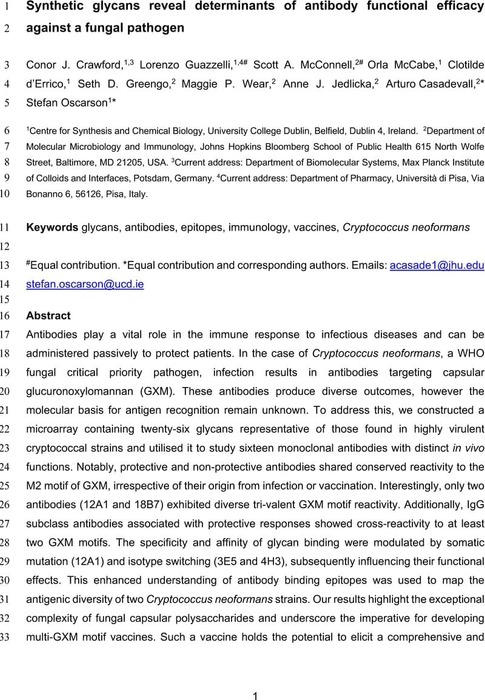Abstract
Antibodies play a vital role in the immune response to infectious diseases and can be administered passively to protect patients. In the case of Cryptococcus neoformans, a WHO fungal critical priority pathogen, infection results in antibodies targeting capsular glucuronoxylomannan (GXM). These antibodies produce diverse outcomes, however the molecular basis for antigen recognition remain unknown. To address this, we constructed a microarray containing twenty-six glycans representative of those found in highly virulent cryptococcal strains and utilised it to study sixteen monoclonal antibodies with distinct in vivo functions. Notably, protective and non-protective antibodies shared conserved reactivity to the M2 motif of GXM, irrespective of their origin from infection or vaccination. Interestingly, only two antibodies (12A1 and 18B7) exhibited diverse tri-valent GXM motif reactivity. Additionally, IgG subclass antibodies associated with protective responses showed cross-reactivity to at least two GXM motifs. The specificity and affinity of glycan binding were modulated by somatic mutation (12A1) and isotype switching (3E5 and 4H3), subsequently influencing their functional effects. This enhanced understanding of antibody binding epitopes was used to map the antigenic diversity of two Cryptococcus neoformans strains. Our results highlight the exceptional complexity of fungal capsular polysaccharides and underscore the imperative for developing multi-GXM motif vaccines. Such a vaccine holds the potential to elicit a comprehensive and effective immune response capable of neutralising the vast antigenic diversity presented by cryptococcal capsules.
Content



![Author ORCID: We display the ORCID iD icon alongside authors names on our website to acknowledge that the ORCiD has been authenticated when entered by the user. To view the users ORCiD record click the icon. [opens in a new tab]](https://chemrxiv.org/engage/assets/public/chemrxiv/images/logos/orcid.png)



